
Special Article: Biomass Production
Ann Agric Crop Sci. 2022; 7(4): 1123.
Sustainable Sources for Cosmetic Ingredients – Evaluation of the Biomass of Crete as a Model Region
Wanninger A¹*, Katerinopoulos HE², Christoforou G², Kräling R¹, Köhler TH¹, Poth K¹ and Spüntrup FS¹
¹Department of Faculty of Chemistry, Hochschule Niederrhein University of Applied Sciences, Germany
²Department of Chemistry, University of Crete, Greece.
*Corresponding author: Andrea Wanninger Hochschule Niederrhein University of Applied Sciences, Faculty of Chemistry, Organic Chemistry/ Consumer Products, Adlerstr. 32, 47798 Krefeld, Germany
Received: November 10, 2022; Accepted: December 21, 2022; Published: December 27, 2022
Abstract
Sustainable sourcing of cosmetic ingredients nowadays includes the use of bio-based raw materials. In order to avoid waste and to use by-products of agriculture in the best possible way, a Material and Energy Management (MEM) system of the bioeconomy has to be established. As a new approach towards sources for cosmetic basics and actives, an evaluation of local biomass was carried out in this study, using the Greek island of Crete – which has a rich endemic flora – as a model region.
Introduction
Sustainability is key to the cosmetic industry today. Not only renewable raw materials are used but the whole product life cycle of the finished product is considered. During production of cosmetic ingredients from natural sources often waste or byproducts are generated, such as the 17 million tons of empty fruit bunches from 60 million tons palm oil production [1] or the residues of sugar cane or sugar beets, yielding only 160 kg of sugar from 1 ton of beets [2]. The total biomass which is used to produce natural cosmetic ingredients sustainably should therefore be considered and all parts of the agricultural biomass or wild-grown plants should be used in the best way applying the criteria and methods of bioeconomy. Nowadays, research is focussing on a value chain for biomass with optimized material flow, thus building a sustainable bio-based economy »from feedstock to product« with regional supply of the feedstock and regional manufacture of value-added chemical specialties.
Cosmetic ingredients are only one example of this revolution in the industry. Plastic or food additives can also be produced from biomass as well as bio-based polymers and platform chemicals as alcohols and acids. And the technologies to come are biorefineries using »biosyngas« (carbon monoxide or carbon dioxide and hydrogen) to produce chemicals and the valorization of waste or sources as lignocellulose. Avoiding waste or even using it as a carbon source for chemicals is also one of the principles of Green Chemistry.
In this paper the island of Crete serves as a model region for the evaluation of its biomass which is suitable for cosmetic ingredients. Interesting about this biggest Greek island is the relative isolation and special climate with about 300 days of sunshine per year. Crete is like a small continent. Cretan olive oil is believed to be the best and healthiest in the world; and the flora is rich with more than 200 endemic plants, many of them with healing properties and effects on skin and hair. Unlike cosmetic actives from other regions of the world, the Cretan flora is so far rarely used in cosmetic products but is worth investigating.
On The Topology and Flora of Crete [5]
Coordinates: 35°13‘N 24°55‘
Area: 8,335.88 km² (3,218.50 sq miles)
Highest elevation: 2,456 m (8,058 ft)
Population (2011): 623,065
Density: 75/km² (190/sq miles)
The total area of Crete is 8,336 sq km and constitutes 6.3 % of the total Greek territory. It is located at the southern edge of the Aegean Sea, at a distance of about 160 sq km. from the mainland. Its coastline is more than 1,000 km long. It is bordered by the Cretan Sea to the north and the Lybian Sea to the south. It is surrounded by a number of small islands (Gavdos, Gavdopoula, Chrysi, Koufonisi, Dia, Dyonisades, etc.). The length of the island from west to east is 256 km. Its largest width of 57 km is located in the Prefecture of Heraklion and the smallest width of 12 km in the Prefecture of Lasithi. Its morphology includes three zones: the mountainous zone, with an altitude of 400m and above, the semi mountainous zone with 200-400 m and the level area which is up to 200 m above sea level. The first two zones cover about three-fifths of the island. The mountainous area is 49% of the island’s area. The predominant mountain ranges are Lefka Ori (2,452 m), Psiloritis (2,456 m) and Dikti (2,148 m).
The mountains surround fruitful plateaus like Omalos, Lasithi and Nida. The Messara in the south is the biggest plain of the island with about 140 km 2. It is used intensively for agriculture.
The island of Crete does not have forests like middle and western Europe. The predominant tree is the olive tree. Some Calabrian pines (Pinus brutia), a few cypresses (Cypressussempervirens) and oak trees are found in the Western mountains. Eastern Crete is very dry. Besides some olive trees and Cretan date palms (Phoenix theophrasti) at the beach of Vai, only bushes like phrygana and macchie grow there. Carob trees (Ceratonia siliqua) and Planes (genus Platanus) are found in areas with more water.
Regarding elevational species richness and endemism patterns on Crete [4] researchers found that »total and subendemic (SUBE) vascular plant species richness monotonically decreases with increasing elevation in Crete, while Single Island Endemic species (SIE) show a unimodal response to elevational gradient...
Moving upwards, following mountain uplift, the Cretan flora was impoverished as a result of environmental filtering and the mountain areas have been mainly colonized by tolerant lowland species. As a result of island and elevation driven ecological isolation synergy, Cretan highlands are more effectively isolated than Cretan lowlands, resulting in increased species impoverishment with increasing elevation...« Their results also support that »tolerant plant species able to withstand the harsh climatic conditions with increasing elevation had to face reduced interspecific competition. Ecological release triggered by increased species impoverishment with increasing altitude has led to elevational range expansion of Cretan plants« and they conclude that »the whole Aegean archipelago, including Cretan area, has a complex geological history and ... there is not only one overriding factor that defines the response of plant species to environmental gradients on continental island systems. A corresponding combination of factors, each one with different intensity and duration of influence depending largely on historical parameters, determines elevational patterns of plant species richness and endemism in Crete«.
The species that grows on the island and the elevation (when known) that each species preferentially grows at are described in a table which is provided separately [5].
Biomass [6,-8]
Biomass is defined as the total of plants - wild and agriculturally cultivated - and wooden substances growing in a certain region. Almost 94% of biomass on our planet consists of lignocellulose, hemicellulose and cellulose. The agricultural products include cultivated crops, vegetables and fruits, nuts, mushrooms, herbs, spices and flowers. A sustainable use of biomass includes the evaluation of which parts of the bio-based material can be used for which purpose. The right »mix« has to be decided for every plant. Possible uses are: food, feed, materials, chemicals, fuel and energy. A value-added use is specialty chemicals like cosmetic ingredients.
Currently for this purpose biomass of the first generation, such as vegetable oils, wheat, corn and sugar, is processed. A development ongoing investigates the use of biomass of the second generation, such as biomass residues from agriculture and forestry.
Olive oil and olives are the most important agricultural product of Crete, followed by oranges and other citrus fruits. Wine and raisins are less important. Bananas, cucumbers and tomatoes are grown in greenhouses in southern Crete, mostly for export. In the Prefecture of Rethymnoavocado products are famous.
Sustainable Production Methods and Cycles
Cellulose forms the main part of the biomass worldwide, and it is present in hardwood as well as in straw or other parts of cultivated plants. Cellulose can be decayed to sugars which are substrates for fermentation processes. More and more research is going on to produce bulk or fine chemicals from these sources.
Cosmetic ingredients can be found in otherwise neglected parts of the plants. Grass and leaves contain valuable ingredients like secondary phenols or proteins which can be extracted in some cases. Pits and kernels either contain oils or can be milled to be used as peeling particles.
Even the residues of leaves and kernels or twigs and trimmings can find their way into specialty chemicals as cosmetic ingredients by combusting them to biosyngas and energy first, followed by fermentation [9].
Challenges from Tourism
Due to tourism with more than 3.3 million visitors per year which is the biggest source of income, the island of Crete faces two major problems: Energy and waste! Not only that some of civilization s waste is simply thrown into small canyons and valleys, it is also combusted in open fires. Agricultural residues are also combusted by the farmers in open fires.
This situation could be changed to create a sustainable solution by producing biosyngas out of municipal and agricultural waste and then transforming this gas into valuable chemical substances by fermentation processes. The thriving tourism industry in the island of Crete, combined with a number of commercial activities, has created a challenge to the Cretan power system. Local demand for electricity has been rising over the past years, with the localconventional power stations of the Public Power Corporation supplying 514.4 MW in June 2000 and facing an annual growth in demand averaging 7–8 % over the last fourteen years.
The additional need of power supply is estimated to be 280 MW in addition to the current installed capacity of 532 MW. The high cost of supplying power to Crete is due to the fact that it includes transportation of fuel oil from the mainland resulting in a substantial net loss to the company.
Therefore, the installation of a biomass based local power plant appears to be a promising solution for the energy problem of Crete.
Problem: Open Fires
Combustion tests performed on biomass samples (vine shoot, olive wood, citrus wood, kernel wood) indicated that the content of combustibles in all samples tested is more than 95 % on a dry basis, a fact that provides evidence for the good quality of these biofuels. The net calorific value of the fuels ranges from approximately 3,500 to 4,500 kcal/kg and is significantly higher than that of Greek lignite (1,000 to 1,700 kcal/kg).
A number of studies emphasizing on the exploitation of the biomass of Crete have been reported in the literature [4,5]. A recent study revealed the extent of the contribution of biomass burning –including wild fires – to aerosol chemical composition in air masses [6].
Olive Oil – The Lifeblood of Crete
When thinking about typical Cretan products, the first is the valuable Cretan olive oil. The cultivation of olives has an amazing history of more than 5,500 years on the island. On average every resident owns 30 trees. In total about 20 million olive trees are said to grow on about 44 % of the arable land. With this amount of trees every year 150,000 to 180,000 tons of olive oil are produced. The weight of harvested olives is even higher, since 4-7 kg of olives are needed to produce a litre of oil. Every tree carries about 20 kg of fruits [10]. The world-wide olive oil production is about 2.9 million tons. 95 % of the 750 million olive trees grow in the mediterranean area, 40 % thereof in Spain. Greece is the third largest producer [11]. The most olive trees in Crete are of the species »Koroneiki« (80-90 %), but in some districts there are rare species such as the »Tsounati« olive. An olive of the species »Koroneiki« has an oil content of about 22 %. This represents about 0.5 g oil. In addition to the oil the olive consists of water (50 %), sugar (19.1%), cellulose (5.8%) and proteins (1.6 %) [10].
The major fatty acid in the oil is oleic acid and olive oil is rich in antioxidants. Of course olive oil itself is used for cosmetic applications such as moisturizing creams, mild eye-make-up remover, shaving oil for sensitive skin, in lip balms together with bees wax or in a peeling containing sea salt. But in order to find more sustainable cosmetic ingredients we should take a look at the process of producing olive oil.
In the majority of cases the harvest of olives starts in November. The olives are hand-picked carefully with the help of large blankets. To avoid bitterness in the olive oil, the olives have to be washed and separated from the leaves and the twigs. Also the chlorophyll would reduce the quality of the oil. After washing, the olives are placed in the grinding pan, where they get crushed and mixed. Nowadays the olive oil is separated from the olive-water and the pomace by decantation. The key is to investigate the waste or by-products which are created in this process. Olive oil production by-products: The average annual production of by-products is estimated at 2.3 million tons p.a. with a yearly increase of 8%. The most well known by-product is the kernel (olive pit), with a thermal value of 3,500-4,000 kcal/ kg. Since the specific weight of kernel is 600-700 kg/m³, it is obvious that it has the relative advantage of large quantity storage as opposed to other fuels such as wood wastes.
Other by-products include the olive husk, the residual pulp of the olive which is processed to yield olive pit; trimmed leaves and twigs, disposed of by the mills and olive tree prunings, disposed of by the farmers locally in open fires. Olive pulp is used as a high-fiber additive for animal feed.
The liquid aqueous fraction contains a high amount of toxic compounds, such as phenols. This waste should not be disposed in the environment.
The Fraunhofer IGB developed a concept to extract the utilisable substances like polyphenols which can be used in the cosmetic industry. The remaining solids can be used to generate biogas by bacterial fermentation. In ten days it is possible to produce 980 litres of biogas per kilogram of olive-paste. For comparison only: 680 litres of biogas per kilogram can be obtained from maize silage [15].
The leaves can be sources of ingredients for cosmetics. The major cosmetic ingredient of the olive leaf is oleuropein which is an antioxidant. The content of oleuropein is much higher in the olive leaf than in the fruit. Other substances included in the leaves are: Phenols (hydroxytyrosol, caffeic acid), flavonoids (olivine, rutin, hesperidin, quercetin), hydrocarbons and organic acids.A possible drawback is the dark colour of the extract. The pits are separated in the oil mill. Since they have a higher caloric value (5.6 kWh/kg) compared to air-dry wood (4-4.4 kWh/kg) they are an alternative biomass fuel to wood-pellets [12]. Olive biomass (pits and trester) is already traded worldwide. But the olive pits can also be used directly for cosmetics. If they are milled to a fine powder they work excellently as peeling bodies in a cosmetic peeling. Mango peels and seed kernel powders have already been analysed and the rheological, physical, sensory and antioxidant properties have been evaluated [13]. And of course the usage of olive oil itself for cosmetic applications could be intensified. The Cretans have recognized the nutritional and medicinal benefits of olive compositions for centuries. And in fact the olive oil contains many ingredients which are valuable for the cosmetic industry.

Figure 1: Coast line and olive trees, western crete.
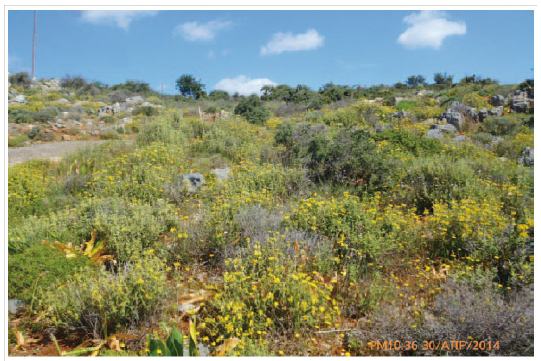
Figure 2: Typical vegetation, Phrygana.
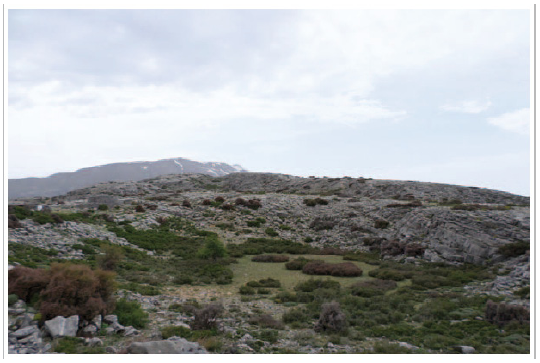
Figure 3: Mounatain of Psiloritis.
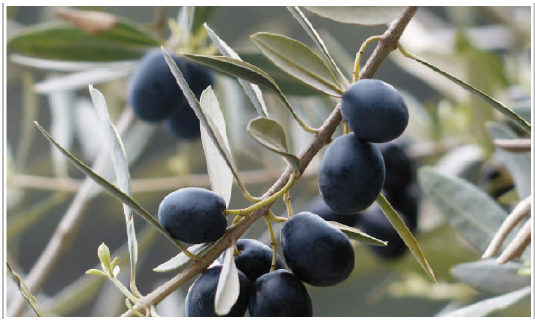
Figure 4: Cretan Olives.
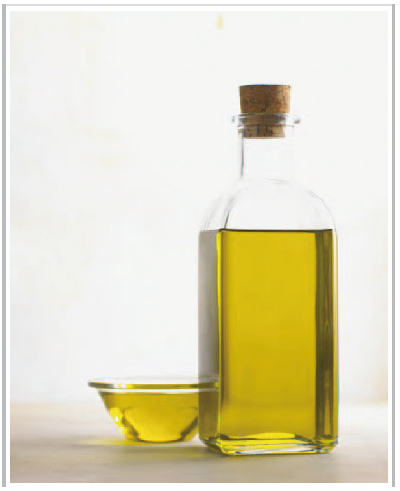
Figure 5: Olive oil - Legendary in Crete.
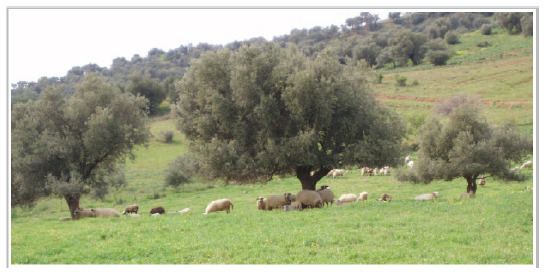
Figure 6: Olive tree.
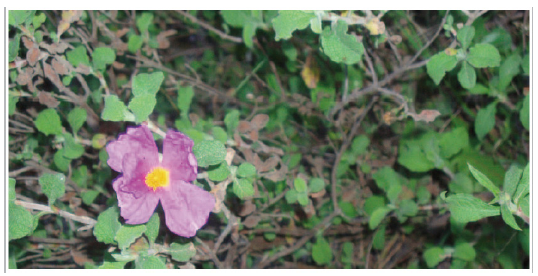
Figure 7: Cistus creticus ssp creticus.
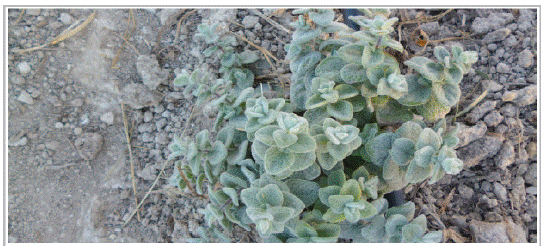
Figure 8: Origanum dictamnus »diktamos«.
(Table 1) shows the compositions of the fatty acids in olive oil.
unsaponifiable
1-1.5%
Waxy esters
0.50%
Palmitic acid
7.5.20%
Stearic acid
0.5.5%
Oleic acid
55.83%
Linoleic acid
3.5.13.5%
Linolenic acid
Max 0.8%
Table 1: Fatty acid composition in olive oil (Olea europea) [14].
The ratio between the different chain lengths of the fatty acids ensures the best compliance towards skin and hair. The ratio is also comparable to the human sebum which is secreted by the sebaceous glands and protects the skin from the environment and reduces the Transepidermal Water Loss (TEWL). In the unsaponifiable fraction there are a lot of antioxidant substances like tocopherols (commonly known as vitamin E). In addition to vitamin E the olive oil contains other liposoluble vitamins like vitamin D3 and vitamin K. Vitamin D3 is able to regulate the epidermal keratinisation by including terminal differentiation in the regulation of hair growth. And apart from the liposoluble vitamins the olive oil also contains pigments with a synergistic antioxidant activity and different phenolic compounds. The company B&T (acquired by HallStar), located in Arcore (Milan) - Italy, has worked since 1991 on the identification, development and industrial production of high-tech standardized raw materials based on olive chemistry [14]. So far the product portfolio contains emulsifiers, stabilizing agents, emollients, surfactants and active ingredients. This shows that the olive and all byproducts are ready for the market. With the knowledge of the olive and the know-how of the processes to extract the olive oil and all the by-products of this process, the olive could become the fundamental pillar of the »Cretan Cosmetics«.
Products from Fruits and Vegetables
The sustainable way of using fruits and vegetables should investigate further the byproducts generated in food and beverage production which are currently regarded as waste. Possible transformations of this part of the biomass include the further use for materials, chemicals, fuel or energy. For every kind of agricultural product the best mix has to be evaluated and calculated in order to avoid waste and to create the maximum value. Personal care ingredients are certainly a valuable form of using the by-products as actives or basic ingredients. Other regions in the world may have the advantage of producing large quantities of olive products (Spain) or oranges (Brazil USA, China) but do not necessarily supply a superior quality in terms of active ingredients.
Grapes, Wine and By-Products
Wine and raisins are produced in the Prefecture of Heraklion. The vine cultivation in Crete has decreased during the last twenty years due to international competition and the European agricultural policy. Major by-products include vineyard prunings which the farmers usually dispose of in open fires, and grapepomace, which is the residual pulp of the grapes generated during the process of wine-making. The available biomass is 190.8 thousand tons p.a.. Many interesting cosmetic raw materials find their origin in the grapes, their husk and seeds, in the vine and its leaves. An overview is given in (Table 2).
Grapes and vine
Use (Personal Care)
Vine extract
Resveratrol (skin active, anti-ageing)
vine juice
Viniferine (tyrosinase inhibition, age spots)
Grapes or vine
Polyphenols (skin active, antioxidant)
Grape seeds
Grape seed oil
Wine yeast
Vinolevure (Moisturizer, immun stimulator)
Grape leaves extract
Antimicrobial for oral care
Grape leaf oil
Fragrance component
Table 2: Cosmetic use of grapes and vine.
Caudalie, a French company, holds patents on cosmetic actives from grapes and vine.
200 kg of vine is necessary to obtain 50 g of pure Resveratrol which increases skin smoothness, density and tone [16]. The juice from vine is called Viniferine, protects against pigment disorders, and is said to be much stronger than Kojic acid or Arbutin.
Polyphenols (INCI: Vitis Vinifera (Grape Wine) Extract) have skin-protecting properties. In particular for their effects against oxidative stress they are often found in anti-ageing products. Oligomeric Procyanidins (OPC), which belong to the class of polyphenols, also have an anti-inflammatory effect and their antioxidant force is forty times stronger than that of vitamin E.
In the grape itself 30 % of the polyphenols are found in the husk, 10 % in the pulp and 60 % in the seed [17]. From 1 ton of grape seeds 1 kg of polyphenols can be obtained. Additionally, this product can be obtained from the vine as well. In wine production first a mash is made. For manufacturing of red wine the pomace is separated after the fermentation, while the pomace is not fermented for the production of white wine.
Grape seed oil (INCI: Vitis Vinifera seed extract) which is mainly used for lipstick foundations as well as moisturizing products is high in polyunsaturates. Due to this, grape seed oil has unique nourishing and repairing properties. It gives a smooth, silky but not greasy finish to the skin. From 50 kg of grape seeds 1 litre of oil can be obtained. The French company Caudalie uses seeds which normally are thrown away in the vineyards. Therefore, this is also an opportunity to use pomace from the wine production and to avoid needless waste. Grape leaf extract has antimicrobial properties and is used in oral care products. Grape leaf oil is used for fragrances. Vinolevure is obtained from wine yeast during wine production. Vinolevure has natural strengthening and protective properties. It acts as a moisturizer and also strengthens the immune system of the skin (Langerhans cells).
Citrus Fruits
Citrus by-products are characterized as follows: oranges can be separated into orange juice and the husk which consists of the white pulp and the peel (including the orange oil). Orange husks are used for animal feeding, while the trimmings are used for heating. The available biomass is 71.7 thousand tons p.a..
The white part of the husk (the pulp) can be transformed to orange fiber (INCI: Citrus Aurantium Sinensis) which can be used for nutrition or in personal care products as an O/W stabilizer [18]. The product is supplied as a white, free flowing powder. It is processable cold and the recommended usage level is 1–5 %.
The outer orange peel contains orange oil which is rich in fragrance components. It contains terpenes like limonene. Vitamin C, a prominent ingredient in fruits and vegetables, is not extracted from oranges but normally produced by fermentation of glucose. All components of citrus products can be used for the different purposes mentioned in (Table 3). Lemons are also cultivated in Crete butare less important in total.
Oragne (or parts)
Use
Orange (whole fruit)
Food
Juice
Beverage
Pulp
Feed
Pulp (fiber)
Food or Personal Care (emulsifier, stabilizer)
Oil from peel
Personal Care (fragrance)
Rest of the peel
Combustion (energy or bio-syngas)
Trimmings (and kernels)
Combustion (energy or bio-syngas)
Table 3: Sustainable value chain for oranges.
Vegetables
Avocado (Persea americana) is well known as a cosmetic ingredient. Especially the Persea gratissima oil is often used for skin and hair care. In the Prefecture of Rethymno, near the village of Argiroupolis, avocado trees have been cultivated more and more over the past 30 years. Currently from about 2,000 trees, a cold-pressed pure organic avocado oil is obtained which is sold and incorporated into personal care products for the Greek market. The avocado oil is approved by the state as organic. The Lappa Avocado oil is absorbed into the skin immediately. It is very rich in lecithin and vitamins A, B, C, D, E, H, K, PP and Omega 3 & 6 fatty acids. The oil has a high tolerability and helps to soothe different skin problems like dry or scaly, itchy skin, diaper rash, but is also suitable for scalp treatment or greasy skin with pimples and acne. The oil keeps the skin soft and supple, increases the skin elasticity and moisture and the production of collagen. It helps to heal skin burns or wounds faster and is also very helpful in skin conditions like eczema and solar keratosis. In hair care it can be used for dry hair [19].
In Crete, more and more small local personal care companies use olive and avocado oil, honey, beeswax, propolis and even extracts of endemic local plants. In particular the Cretan company Bioaroma near Agios Nicolaos produces essential oils and personal care products using the rich flora of Crete [20].
Other Applications of Vegetables: Nutricosmetics
In the past decade nutricosmetics have gained importance in the form of beauty capsules, drinks, chocolates or dairy products. Some plant extracts, preferably from fruits and vegetables, are used, promising anti-ageing activity, protection against sun-damage or benefits for hair, scalp and nails. Typical ingredients are antioxidants like Betacarotene (normally industrial), Lycopene (from tomato husks) or even broccoli extract.
All parts of the tomato which is cultivated in Southern Crete in large greenhouses, can be used. Cosmetic applications are possible for the peel extract (Lycopene) and the extract of the kernels. The concept of »beauty from within« is known for ages in Crete, along with the mediterranean diet which is said to prevent heart diseases and diabetes.
Products from Herbs, Spices and the Natural Wild
A walk in the nature gives a rich impression of the typical scents of Crete. Hills are covered with wild thyme, oregano, Greek sage, diktamos and thymbra-calamint. The vegetation is even found on the mountains. All over the island, herbs and spices for food and tea are collected and also sold to local inhabitants and tourists. »Botano« in Kousés/Messara offers the largest variety and best selection of plants as well as a special dark olive oil- of a very early harvest - which is like a pharmaceutical active full of polyphenols [21]. The ingredients of herbs and spices can of course be isolated or the plants can be used in total in a dry form.
Extracts and teas from pink rock rose Cistus Incanus are traditionally used for health purposes in Greece. Cistus creticus L is the species which is found in Crete. The »harvest« of the active, a glue-like resin, is collected by treating the bushes with a rawhide.
Cistus found its way into the world of cosmetic actives for mature skin: the company Rahn offers a blend of Cistus Incanus Flower/Leaf/Stem Extract, an extract from a special Asian vine and an amino acid. The active ingredient Reforcyl has highly substantiated scientific claims: it improves deep wrinkles in the eye area, hydration, firmness, elasticity, skin smoothness, and the strength of the skin barrier [22].
Endemic Plants of Crete [24]
Many plants that compose the flora of Crete are endemic species or subspecies that cannot be found elsewhere in the world. The endemic plants of the island are estimated to be approximately 210 species and subspecies, consisting of 44 % of the endemic plant population of the Aegean islands. This large endemic plant number is due to the fact that, although Crete was once connected with neighboring continents, it was still quite isolated for an extended time period. Thus, under the impact of geographic isolation, many species differentiated in such an extent that new species or at least subspecies emerged. Another characteristic of the Cretan flora is that its endemic plants are mostly found in secluded areas, such as the White Mountains (Lefka Ori) in Western Crete, the mountains of Sitia in Eastern Crete, and areas south of the plain of Messara. Some endemic species can be found throughout the whole island, sometimes as different subspecies, while others are limited in eastern or western Crete. An example is Scabiosa albocincta, abundant in western Crete, and its relative Scabiosa minoata found in eastern Crete.
The existence of such a large number of plant species in a relatively small area like Crete has for a long time attracted the attention of investigators. It is estimated that there are about 2,000 species of superior plants, not counting the subspecies. This number represents more than a quarter of the total species in the Greek flora. The most impressive though, is the number of the endemic plants that grow exclusively on the island. From a total of approximately 700 Greek endemic species, about 250 grow in Crete and 160 of them are exclusively endemic. This number keeps rising, since even nowadays new rare species are found hidden in isolated canyons, or in remote mountainous areas.
It is believed that among the endemic plants in Crete, six are threatened with immediate extinction because of their small surviving numbers and the fact that most of their biotopes have been destroyed, while fifteen more are in danger but not immediately threatened with extinction, 78 are rare, 4 are not fully identified, and the rest are in such abundance that they are not facing any danger of extinction.
Healing Properties of Endemic Plants [23,25]
Most of the plants of Crete are known to have healing properties for many diseases and have been used by the locals or the traditional medicine from ancient times until today. In some cases the plant scan be dangerous and cause serious health problems such as poisoning or even death. The endemic plants of the island have an interesting history of uses and they are still used for healing purposes.
The industry of cosmetics could certainly use many of their extracts for their known properties as natural sources. Some examples of the endemic plants of Crete with interesting known properties that can be relevant to skin or hair repair are mentioned here. Firstly, there is Asplenium creticum, called »chrisochorto« in Crete, that is being used, beside other things, for youth acne. There is also »Herniaria parnassica Ssp. Cretica« which is used as a softener and for ruptures. Also, the genus Hypericum is famous for its wound healing properties. Furthermore, Crocus oreocreticus, also known by the locals as »zafora«, is used as a pigment and for hair care. In addition, one of the most famous and well used endemic plants of Crete is Origanum dictamnus, otherwise called »diktamos«, which is used for many applications such as wound healing and antiswelling. Muscari spreitzenhoferi is another plant that is used for healing swellings, rheumatisms abscesses and sprains. Last but not least, the genus called »Gallium« is worth mentioning due to its properties for healing many skin conditions. The list of interesting plants is quite long and it is certainly worth studying them further for their properties and their use in personal care and pharmaceutical products. The list of endemic plants is in a table which is provided seperately [26].
Summary and Outlook
By calculating the best mix to use of the biomass, in particular of the big agricultural products olives, wine grapes and oranges, a value chain could be created and a sustainable cycle of material flow could be obtained. Thus, Material and Energy flow Management (MEM) is a key discipline for the future. The waste and the energy problem of Crete could be minimized. Using biomass to produce cosmetic ingredients could be further established and the interesting »side streams« of bio-based products should be further investigated.
But what makes Crete really special and worth looking at from the view point of cosmetic actives is the typical flora of spices, herbs and endemic plants with healing properties and a long history of application by the Cretan people. Just as Morocco has the argan oil, Crete has the »diktamos«.
References
- Bellof M. Oral presentation at the CIC. 2014. Düsseldorf.
- Schaper A. Oral presentation at the CIC 2014. Düsseldorf.
- Region of Crete. 2014. http://www.crete.gov.gr/index.php?optio on=com_content&view=article&id=4135&Itemid=287&lang= en#.VJfiHsgs.
- Trigas P, Panitsa M, Tsiftsis S. Elevational Gradient of Vascular Plant Species Richness and Endemism in Crete – The Effect of Post-Isolation Mountain Uplift on a Continental Island System. PLOS ONE. 2013; 8: e59425.
- http://www.nhmc.uoc.gr/sites/default/files/announcements/ xlwrida.xls. 2014.
- Vamvuka D, Tsoutsos TD. Energy Exploitation of Agricultural Residues in Crete. Energ Explor Exploit. 2002; 20: 113-121.
- Boukis I, Vassilakos N, Karellas S, Kakaras E. The exploitation of biomass for building space heating in Greece: Energy, Environmental and Economic Considerations. Sust Energ Rev. 2009; 13: 362-377.
- Bougiatioti A, Stavroulas I, Kostenidou E, Zarmpas P, Theodosi C, et al. Processing of biomass-burning aerosol in the eastern Mediterranean during summertime. Atmos Chem Phys. 2014; 14: 4793–4807.
- Haas Th. Oral presentation at the CIC 2014. Düsseldorf.
- http://www.kreta-reise.info/Hauptseiten/olivenbaum.htm.
- GEA: Generate Magazin. March 2008; 5: 4-7
- http://www.biomass-center.com/olivenkerne.htm.
- Ashoush IS, Gadallah MGE. Utilization of Mango Peels and Seed Kernels Powders as Sources of Phytochemicals in Biscuit. World Journal of Dairy & Food Sciences. 2011; 6: 35-42.
- http://www.btcompany.com/olive_in_cosmetics.asp
- http://www.igb.fraunhofer.de/de/pressemedien/presseinformationen/ 2011/bioenergie-aus-olivenoelabfaellen.html.
- http://de.caudalie.com/patente-aktivstoffe/unsere-patenteaktivstoffe. html#patentyourskin-content.
- Walther R. Oral presentation; Polyphenol-Extrakte von Trempanillo Trauben. SEPAWA. Fulda 2014.
- http://www.imulsi-fi.com.
- http://www.lappa-avocado.gr.
- http://www.bioaroma.gr/gb/.
- Yiannoutsos G. http://www.botano.gr.
- http://www.rahn-group.com/de/cosmetics/produkte/19/ (accessed on 22.01.15).
- Alimpertis A. »Healing, aromatic and edibleplants of Crete«, Efstathiadis Group, Mystiseditions, Heraklion Crete, 2006.
- Sfikas G. »Wild flowers of Crete«, Efstathiadis Group, Athens, 1999.
- Havakis I. »Plants and Herbs of Crete«, Zita, Athens, 1978.
- www.sofw.com/content/news/SOFW_0115_Article_HS_endimika- 1.xls (accessed on 23.01.2015). Endemic flora of Crete, see as well: http://www.nhmc.uoc.gr/en/